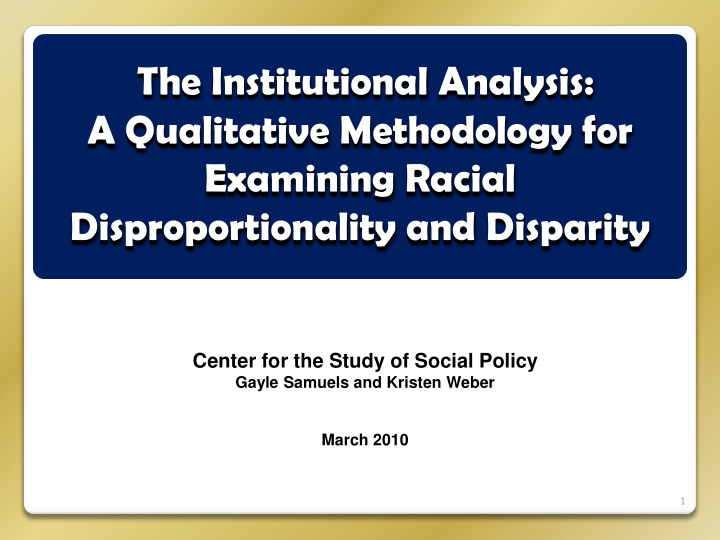



The Institutional Analysis: A Qualitative Methodology for Examining Racial Disproportionality and Disparity Center for the Study of Social Policy Gayle Samuels and Kristen Weber March 2010 1
Outline of Presentation Brief overview of national data and work on racial disproportionality and disparity Institutional Analysis/Methodology Michigan Experience/Findings 2
Disparities Children of color are overrepresented at all decision points of the child welfare system: reporting, investigation, substantiation, placement, and exit from care . They experience: higher occurrence of placement changes longer stays in protective custody lower rates of legal permanency 3
What produces racial disproportionality and disparity? Individual worker bias? Poverty? Heighten scrutiny of a particular community? Lack of meaningful community-based resources? Institutional polices and practices? System and worker fear of lawsuits, media coverage, etc...? Something else? 4
What are States doing? Eleven states -- California, Connecticut, Florida, Iowa, Illinois, Indiana, Massachusetts, Michigan, Minnesota, Texas, and Washington — have addressed racial disparities and disproportionality through public policy activities. Legislation, Policy Change, Finance Reform Youth, Parent and Community Partnership and Development Human Service Workforce Development Practice Change Research, Evaluation and Data-Based Decision-making 5
Qualitative Research Qualitative researchers study things in their natural settings in order to make sense of or interpret phenomena Use and collection of variety of empirical materials: *Case Studies; *Personal Experiences; *Introspections; *Life Stories; *Interviews; *Observations – that describe the routine and problematic moments of the visible world. 6
What is an Institutional Analysis? An analysis is a qualitative methodology that uncovers how a particular outcome is produced. The analysis looks at the GAP between what a child, youth, or their families need in order to be safe and what the institution is set up to do… 7
Institutional Analysis CHILD WELFARE Health Care Housing Lived Experience 8
PRESUME… every worker is coordinated and organized to think about and act on cases in institutionally authorized or acceptable ways 9
Standard Case Processing Structures 10
Michigan Institutional Analysis Advocacy MI Task Equity Institutional Community Legislature Force Report Analysis 11
Analysis Elements Preparation > Quantitative Data Collected > Groundwork with Jurisdiction Conducted > Review Question Narrowed: How does it come about that, after substantiation of neglect, African American children are more likely to be removed from their homes? 12
Michigan Total #/% of Children by Race as Defined by Investigation Process Children’s Alaskan Asian/ African Am./ Unable to Services Data Native or Pacific Hispanic White Black Determine Analysis Native Am. Islander Children involved in 282 0.8% 146 0.4% 13,248 36.4% 1,290 3.5% 491 1.3% 20,940 57.5% CPS Investigations Children w/ Substantiated 235 0.9% 98 0.4% 10,300 37.6% 931 3.4% 349 1.3% 15,476 56.5% Investigations Children w/ Opened CPS 146 0.8% 83 0.4% 6,900 35.8% 682 3.5% 264 1.4% 11,197 58.1% Case – No Removal Children Removed from home: 91 1.1% 15 0.2% 3,341 41.6% 233 2.9% 84 1.0% 4,266 53.1% Substantiated Investigation Children involved in Child Protective Services Investigations and Disposition by Race: Calendar Year 2005 Source: Michigan Department of Human Resources 13
Summary of On-Site Data Collection Type of Interview Saginaw Wayne County Case-based Interview 12 16 Individual 50 106 Birth parents, youth, Birth parents, youth, Focus Groups and foster parents foster parents, AAGs, protective services specialists, protective services supervisors, and TDM meeting facilitators Hotline, investigations Hotline, investigations, Observations TDM meetings, family TDM meetings, family court, juvenile detention court Review of Case Files 40 20 14
Analysis Elements (cont.) Synthesizing Data Write Report – Findings and Recommendations Ongoing Work with jurisdiction 15
FINDINGS Lack of preventive services and inadequate access to services Intrusive interventions Problematic case processing Poor advocacy Courts not acting as a ―check and balance‖ Placement away from family 16
Lessons Learned Constantly emphasize the need to identify and address institutional racism Anticipate turnover within system and advocacy community Advocacy community must continually pressure systems to make necessary changes Fold recommendations and agenda for change into larger reform efforts 17
For mo more e inf nforma rmation: tion: www.cssp.org Gayle Samuels gayle.samuels@cssp.org Kristen Weber kristen.weber@cssp.org 18
Recommend
More recommend